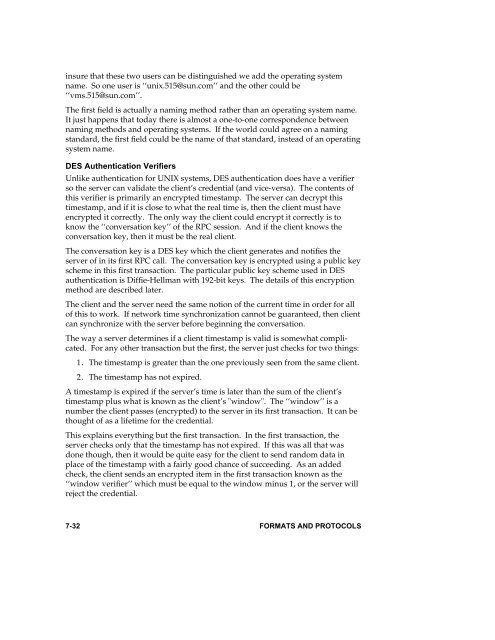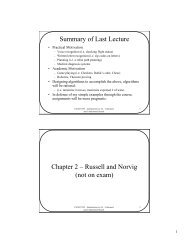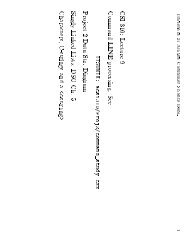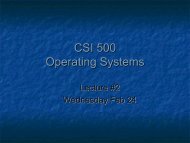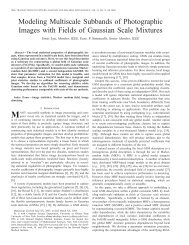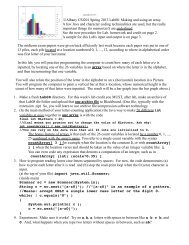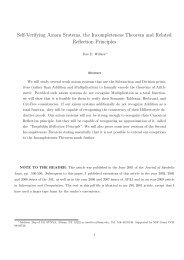- Page 1 and 2:
SYSTEM VAPPLICATION BINARY INTERFAC
- Page 3 and 4:
LOW-LEVEL SYSTEM INFORMATION3Introd
- Page 5:
INIndexIndexIN-1ivTable of Contents
- Page 8 and 9:
1 INTRODUCTIONSystem V Application
- Page 10 and 11:
Foundations and Structure of the AB
- Page 12 and 13:
How to Use the System V ABIThe comp
- Page 14 and 15:
6 . The system’s compilation syst
- Page 16 and 17:
Definitions of TermsThe following t
- Page 18 and 19:
2SOFTWARE INSTALLATIONSoftware Inst
- Page 20 and 21:
Software Structure of the Physical
- Page 22 and 23:
Figure 2-2: Data Stream File Layout
- Page 24 and 25:
A special new-line terminated chara
- Page 26 and 27:
P S T A M P: Production stamp, limi
- Page 28 and 29:
major: The major device number, app
- Page 30 and 31:
NOTESince substantive differences e
- Page 32 and 33:
1: fatal error2: warning3: interrup
- Page 34 and 35:
Commands That Install, Remove and A
- Page 36 and 37:
IntroductionThis chapter defines lo
- Page 38 and 39:
Machine Interface (Processor-Specif
- Page 40 and 41:
Operating System Interface (Process
- Page 42 and 43:
4OBJECT FILESIntroduction 4-1File F
- Page 44 and 45:
Figure 4-1: Object File Format_____
- Page 46 and 47:
ELF HeaderSome object file control
- Page 48 and 49:
e _ v e r s i o ne _ e n t r ye _ p
- Page 50 and 51:
E I _ C L A S SE I _ D A T AThe nex
- Page 52 and 53:
SectionsAn object file’s section
- Page 54 and 55:
Figure 4-8: Section Headert y p e d
- Page 56 and 57:
S H T _ N U L LThis value marks the
- Page 58 and 59:
A section header’s s h _ f l a g
- Page 60 and 61:
Figure 4-13: Special Sections (cont
- Page 62 and 63:
. s h s t r t a b This section hold
- Page 64 and 65:
Symbol TableAn object file’s symb
- Page 66 and 67:
S T B _ W E A K Weak symbols resemb
- Page 68 and 69:
As mentioned above, the symbol tabl
- Page 70 and 71:
# d e f i n e E L F 32 _ R _ S Y M
- Page 72 and 73:
5PROGRAM LOADING ANDDYNAMIC LINKING
- Page 74 and 75:
Program HeaderAn executable or shar
- Page 76 and 77:
P T _ D Y N A M I CP T _ I N T E R
- Page 78 and 79:
Figure 5-3: Segment Flag Bits, p _
- Page 80 and 81:
depending on the processor. See ‘
- Page 82 and 83:
NOTENote information is optional. T
- Page 84 and 85:
Dynamic LinkingProgram InterpreterA
- Page 86 and 87:
Because every ABI-conforming progra
- Page 88 and 89:
Figure 5-10: Dynamic Array Tags, d
- Page 90 and 91:
D T _ R P A T HD T _ S Y M B O L I
- Page 92 and 93:
If a shared object name has one or
- Page 94 and 95:
oth the symbol table and the chain
- Page 96 and 97:
6 LIBRARIESIntroduction 6-1Shared L
- Page 98 and 99:
IntroductionEvery ABI-conforming sy
- Page 100 and 101:
Dependencies Among LibrariesInter-l
- Page 102 and 103:
Figure 6-2: l i b s y s Contents, N
- Page 104 and 105:
NOTEBecause the ABI specifies neith
- Page 106 and 107:
_nameThis gives a system service na
- Page 108 and 109:
Figure 6-7: l i b c Contents from X
- Page 110 and 111:
i n t _ _ f l s b u f ( i n t x , F
- Page 112 and 113:
Network Services LibraryThe Network
- Page 114 and 115: Figure 6-14: l i b n s l Contents,
- Page 116 and 117: Curses LibraryThe curses library, l
- Page 118 and 119: Figure 6-19: l i b c u r s e s Cont
- Page 120 and 121: X Window System LibraryThe X Window
- Page 122 and 123: Figure 6-21: l i b X Contents (cont
- Page 124 and 125: Figure 6-21: l i b X Contents (cont
- Page 126 and 127: X Toolkit Intrinsics LibraryGThe X
- Page 128 and 129: Figure 6-23: l i b X t Contents (co
- Page 130 and 131: System Data InterfacesStandard head
- Page 132 and 133: 7FORMATS AND PROTOCOLSIntroduction
- Page 134 and 135: IntroductionThis chapter describes
- Page 136 and 137: a r _ d a t ea r _ u i da r _ g i d
- Page 138 and 139: As an example, the following symbol
- Page 140 and 141: Terminfo Data BaseEach terminal’s
- Page 142 and 143: 37 | t t y 37 | A T & T m o d e l 3
- Page 144 and 145: XDR Data TypesEach of the sections
- Page 146 and 147: Single-Precision Floating-Point+ --
- Page 148 and 149: Byte m of the sequence always prece
- Page 150 and 151: Variable-length ArrayCounted arrays
- Page 152 and 153: VoidAn XDR void is a 0-byte quantit
- Page 154 and 155: Optional-data is not so interesting
- Page 156 and 157: Because of transport independence,
- Page 158 and 159: 5 . The parameters to the remote pr
- Page 160 and 161: The RPC Message ProtocolThis sectio
- Page 162 and 163: ** Body of a reply to an RPC reques
- Page 166 and 167: The client too must check the verif
- Page 168 and 169: * a d v _ w i n v e r f ; -- one ha
- Page 170 and 171: pcbind MechanismAn r p c b i n d me
- Page 172 and 173: The parameters and the argument poi
- Page 174 and 175: Commands for Application ProgramsPr
- Page 176 and 177: 9EXECUTION ENVIRONMENTApplication E
- Page 178 and 179: Per-process environment information
- Page 180 and 181: The root directory of the file syst
- Page 182 and 183: u s r / X / l i b / a p p - d e f a
- Page 184 and 185: The System V Window SystemNOTEThis
- Page 186 and 187: System V Window System ComponentsTh
- Page 188 and 189: 11DEVELOPMENT ENVIRONMENTSFOR AN AB
- Page 190 and 191: a sSVID ___________________________
- Page 192 and 193: Static ArchivesFrequently applicati
- Page 194 and 195: t_rcv 12-12t_rcvconnect 12-12t_rcvu
- Page 196 and 197: Required STREAMS Devices and Module
- Page 198 and 199: Required Transport Layer SupportA t
- Page 200 and 201: Figure 12-9: XTI values for t_info
- Page 202 and 203: Optional Internet Transport Support
- Page 204 and 205: t_optmgmtTLIUnder TLI the following
- Page 206 and 207: Figure 12-14: IP OptionsX__________
- Page 208 and 209: IN IndexIndexIN-1Table of Contentsi
- Page 210 and 211: a u t h d e s _ f u l l n a m e 7:
- Page 212 and 213: d e l _ c u r t e r m 6: 22d e l e
- Page 214 and 215:
f t o k 6: 5f t r u n c a t e 6: 12
- Page 216 and 217:
installation mediafile formats 2: 1
- Page 218 and 219:
m k s t e m p 6: 12m k t e m p 6: 1
- Page 220 and 221:
format 4: 1hash table 5: 13, 17, 21
- Page 222 and 223:
e p l y _ s t a t 7: 27required siz
- Page 224 and 225:
s i g s e n d 6: 5s i g s e n d s e
- Page 226 and 227:
T _ C O N N E C T 1 12: 5T _ C O N
- Page 228 and 229:
u n a m e 6: 6, 9: 1u n c t r l 6:
- Page 230 and 231:
w r i t e 6: 5, 18w r i t e v 6: 5w
- Page 232 and 233:
X D e f a u l t V i s u a l 6: 27X
- Page 234 and 235:
X G e t G e o m e t r y 6: 27X G e
- Page 236 and 237:
X r m P u t L i n e R e s o u r c e
- Page 238 and 239:
X t C v t I n t T o P i x e l 6: 31
- Page 240:
X t S t r i n g s 6: 32X t S u p e


